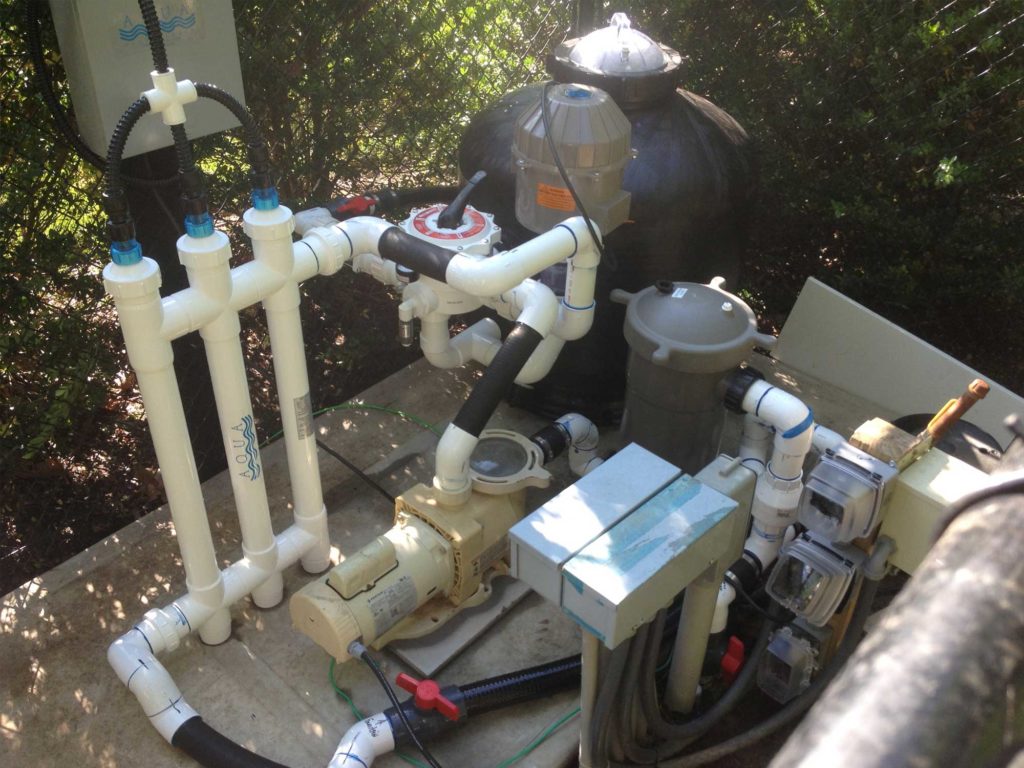Filtration Systems
Working in conjunction with proper pond design, one must choose the optimum filter for the best possible result. These filters may include Trickle Towers, Bead Filters, Bog Filters, Vortexes, Skimmers, Bottom Drains, and Aeration. There are two forms of filtration, Mechanical & Biological. Mechanical filtration is simple; it is the removal or trapping of solid particles (detritus) in the water to make the water crystal clear and 100% viewable. Biological Filtration is something different. It is called the “Nitrifying Cycle”. It is when “beneficial bacteria” cleans the water. This “cleaning” is about making the water healthy for fish. Beneficial bacteria grow on the the filtration media and live in the filter. Ammonia is first created when fish pollute the water. Other causes of ammonia can decaying matter, entrapped sludge in bottom gravel, dead algae or uneaten fish food. Ammo is toxic to fish. So first bacteria named nitrosomonas grows in the filter and eats the ammo and turns it into nitrites. Nitrites are ammo like and are toxic to fish as well. A second closely related bacteria then grows in the filter along with the first bacteria. This second bacteria is called Nitrobacter. This converts nitrites to nitrates. Nitrates are not toxic to fish at low levels. Normal water changes and plant life can eliminate and control nitrates. Nitrifying bacteria have a few basic requirements.
- Oxygen – This is created threw aeration and moving water. Moving water through the media is key for bacteria growth.
- Temperature – At 50 degrees F – starts to grow
- Food – The is created by organic breakdown and fish pollutants which is always ammo first.
- Housing – A place where the bacteria can live and thrive, die and reproduce. This is the filter media itself.
Trickle Towers:
My personal biological favorite. This filter is a bio filter only not a mechanical one. The trickle tower or the wet/dry filter is a filter that exists above the water level and receives water from the pond. This filter is after any other mechanical filter in the system. The pump can only be placed before the filter and water flow back to the pond via run back gravity. The filter works on the principle where water is “showering” or “trickling” over filter media. This will create the greatest amount of beneficial bacteria because of the high levels of oxygen.
Bead Filters:
Bead Filters are filters that exist above or below the water level of the pond. Beads are called pressure filters and are located after the pump in the water flow. They are excellent for mechanical and biological filtration. With the aid of an air blower agitator the bead filter backwashes with ease. Bead filters are pretty much the go to filter and is my filter of choice for the pond. They can work in conjunction with a mechanical filter such as a canister basket or sieve.
Bog Filters:
Bog Filtration or wetland filtration, is when plants filter the water and eat the nutrients, or nitrates, created by the bio bacteria. Bogs are usually gravel or stone filters. Bacteria grows in the rock where the plants are and it is considered natural filtering. However, plants work slowly in nutrient uptake and really only need to be planted at edges of the pond and bog. Plants will then consume nutrient gradually. Gravel is poor in surface area compared to other filter media and is my least preferred media to use.
Vortex Filters:
The Vortex Filter is a cylindrical container that is set level and adjacent to the pond connected via a bottom drain. This is a gravity-fed system where water enters the drain and is pulled through the vortex by an external pump or a submersible pump. This water is spun around where sediment and solids fall to the bottom of the vortex and then can be eliminated through a purge valve. The vortex is not a biological filter but a mechanical one. A gravity bio filter can then be in place with filter pads for biologic. The vortex & gravity bio consumes much more space and must be level with the water to work which requires more excavation to accommodate. They also can only handle a minimum amount of flow to function. They are the “old school” method of filtration. Gravity pull filtration is still excellent with the newer technologies in filtration.
Skimmers – Bottom Drains:
Pond skimmers and bottom drains are similar to those in an in-ground pool. Pond skimmers are excellent for eliminating debris that enters the pond by its surface. The pond skimmer is an excellent area for automatic fill values and overflow ports. Skimmers can be used as the sole method for moving water from a water garden only, a monthly vacuuming is necessary to remove solids from a gravel free bottom. A skimmer can be run via an external pump or a submersible pump hat is in the skimmer.
Bottom Drains are outstanding and are recommended in every Koi pond. They are 100% effective in removing solids off the bottom.
Aeration:
Dissolved oxygen is crucial in a pond with fish and is necessary for nitrifying bacteria to exist and thrive. Aerators are external to the pond and bring air to the pond through air stones or an air diffuser that is located on the top of the bottom drain. You must have aeration any in a pond with fish.

